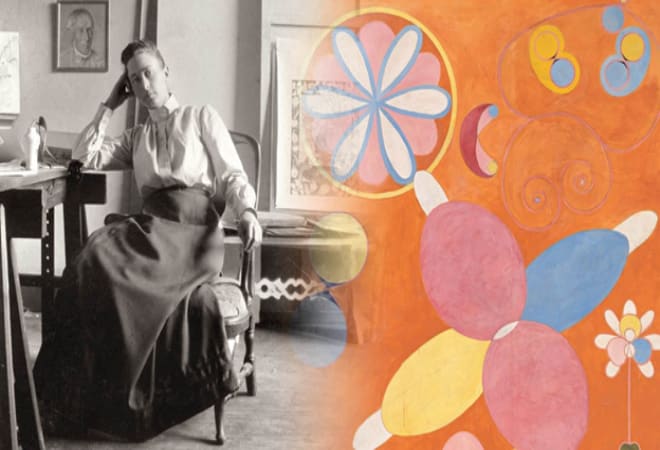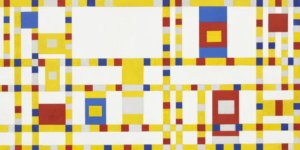Wassily Kandinsky (1866–1944) is often cited as the father of abstract art. However, much earlier than he created his first abstractions, Hilma af Klint (1862–1944), a Swedish artist, had already developed her own abstract compositions. More precisely, this happened by 1906 — several years before Wassily Kandinsky, Piet Mondrian, or Kazimir Malevich; yet, they are still seen as the pioneers and founding fathers of 20th-century abstractions. But who was Hilma, and why is her work so important?
A World Beyond Our Own
Hilma af Klint, a pioneer of abstract art, was creating art to explore a spiritual dimension to life to visualize the context beyond what we see in our eyes. She passionately believed that, when she painted, a higher consciousness spoke through her and communicated spiritual awareness. Like many of her contemporaries, she was very much influenced by spiritual movements, such as theosophy and anthroposophy.
Her paintings are considered a form of automatic writing or “automatic art” — where she received information from an outside source that helped guide what colors should be used and how they could interact with each other on the canvas. Often, these were messages about consciousness itself and advice for bettering oneself spiritually by understanding their relationships with others. All through drawings without words, leaving viewers’ interpretations open to broad ranges of ideas and emotions.
In her will, she ensured that the public might only see her works at least twenty years after she passed away, as she believed that their whole meaning would not be understood by people of her time.

Learning To Visualize The Unseen
Although Hilma af Klint died in 1944, which is well over half a century ago, her name has been shaking up the art world in recent years with her innovative abstract paintings. Her compositional features were bright and stunningly bold; some of them were even monumental in size. One thing that makes it so different from her contemporaries is that they are non-representational and metaphysical abstractions for people to figure out what is beyond the shapes and colors. The ongoing art historical debate about who invented this type of painting may still point to Wassily Kandinsky and other modernists, even though her works pre-date theirs by a few years or more at least. That is why other critics argue for af Klint and for the art historical timeline and rightful authorship of abstract paintings that should be acknowledged to this unknown pioneering woman artist.
Without a doubt, Hilma af Klint was an artist who had a unique talent for drawing — she attended the Royal Academy of Fine Arts in Sweden, which helped shape her artistic skills and abilities, graduating with honors. However, shortly after graduation, Hilma rejected formal training because it no longer interested her as much as spiritualism in her art-making. Because of that, she left the academy, joined Madame Blavatsky’s Theosophical Society, and started The Five group in 1896. The Five would often hold spiritual séances or communicate with spirits through drawings while taking detailed notes on their experiences and practicing creating art without any conscious effort — the so-called automatic drawing.
Her first major commission came in 1904 when she was instructed to paint a series of works named “The Paintings for the Temple,” which would eventually occupy her time until 1913. The commissioner was not a human being — rather, she received those instructions from the spirit world.

What Can We See of Her Work Today?
Hilma af Klint led a quiet life focused inward on mediumistic artwork, which led to an extremely extensive oeuvre of over 1,300 paintings and 125 notebooks that were eventually passed down to her nephew, Erik af Klint, when she died in 1944. One final request by her was to be given 20 years before any exhibition could happen so as not to break apart such an incredible archive of her lifelong dedication. Her life was largely spent inwardly focused on meditative artworks; therefore, they were rarely shared with the rest of the world, even when opportunities for exhibiting or sharing work presented throughout her lifetime.
The first major exhibition of her work in the US was 74 years after her death, named “Hilma af Klint: Paintings for the Future” and hosted by the Guggenheim Museum, NYC, lasting until April 23rd, 2019. The exhibition became the most visited show in the museum’s history, with over 600,000 attending to view her works. By now, it is no secret that the once-unknown Swedish painter has been lauded for her innovative and influential work that was truly ahead of her own time and generations. Moreover, this exhibition also made history in many ways for af Klint as an artist. Not only does it show a selection of pieces spanning over 100 years and showcasing how she experimented with shapes and colors to create masterpieces like “The Maelstrom,” but it was also the first time any museum outside Scandinavia featured a major art installation from af Klint’s estate.
Recently, af Klint is getting more recognition — Halina Dyrschka, a German filmmaker, has directed a documentary movie on Hilma’s eccentric life and prolific art career, which was released in 2019. It served as part of the effort to rewrite art historical timelines predominantly centered around men and bring excitement and revelation of her brilliant ingenuity to the public and art lovers alike that should have been recognized a long time ago.


![[Left] Kusama with her piece Dots Obsession, 2012, via AWARE, [Right] Yayoi Kusama (Courtesy Whitney Museum of American Art) | Source: thecollector.com](https://www.artdex.com/wp-content/uploads/2024/04/Left-Kusama-with-her-piece-Dots-Obsession-2012-via-AWARE-Right-Yayoi-Kusama-Courtesy-Whitney-Museum-of-American-Art-Source-thecollector.com--300x172.png)




